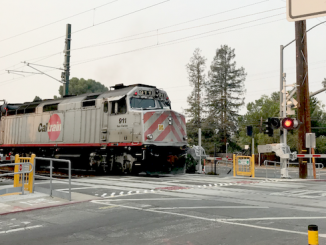
BY ALLISON LEVITSKY
Daily Post Staff Writer
Caltrain saw 1.9% fewer weekday commuters in April 2019 than in April 2018, continuing a six-month trend of declining weekday ridership when compared to the same months last year.
The start of the decline coincided with monthly passes going up in price in October. The passes, which cost between $96 and $433.50 a month, are now based on 13 days per month instead of 15.
Caltrain spokesman Dan Lieberman said it’s possible that the ridership decline has to do with crowded trains.
“Many of our peak-hour trains are over seating capacity, which may well be discouraging people from riding with us,” Lieberman told the Post in an email. “In the short term, we’ve added more six-car train sets to the fleet to combat this overcrowding, and in the long term, electrification will provide expanded capacity as well as new and more comfortable train cars and a faster commute.”
‘Calibrated’ numbers
A report from Chief Operating Officer Michelle Bouchard to be discussed at Thursday (June 6) morning’s board meeting states that Caltrain tracked an average of 67,728 one-way rides per weekday during April 2019, down from a “calibrated” weekday average of 69,061 in April 2018.
Lieberman said the agency “calibrates” its ridership numbers to factor in riders who use employer-provided Go Pass and monthly passes, which weren’t factored in to the original April 2018 daily ridership number.
Average daily ridership, however, has been falling for several months compared to the previous year. It dropped in October by 4.3%, November by 5.2%, December by 4.2%, January by 2%, February by 3.6%, March by 1.7% and now by 1.9% in April.
Still, April 2019 saw 1.7% more overall riders than April 2018: 1.59 million, up from a “calibrated” April 2018 figure of 1.57 million.
One explanation for that total ridership increase, Bouchard said, is that April 2019 had one more weekday and one less Sunday than April 2018 did.
Riders counted twice each day
Caltrain, like other transit agencies, counts passengers when they board in the morning and when the take the return trip home in the afternoon, so the actual number of people riding the train each day is about half the above numbers or around 33,500 people.
The transit agency also collected 15.7% more fares in April 2019 than in April 2018, from up to $9.6 million from $8.3 million.
Caltrain sold 1,051 fewer monthly passes in April 2019 than in April 2018.
“It’s possible that some riders chose to stop buying monthly passes as a result, particularly considering many riders have flexible work schedules (as is demonstrated by our lower ridership on Mondays and Fridays) as well as the rollout of the Caltrain mobile app offering riders a new, easy way to pay,” Lieberman told the Post. “We’ve also seen increases in Clipper users on board, as well as among Go Pass eligible riders, which could also represent some of the people who no longer purchase monthly passes.”
Other statistics
The train was on time more often in April 2019 — 93.6% of the time — than in April 2018, when it was on time 92.6% of the time.
There were 24 fewer minutes of delay in April 2019 than in April 2018, down to 16.4 hours from 16.8 hours.
Despite this April’s more timely service, Caltrain received three more complaints per 100,000 passengers in April 2019 — 8.1 complaints per 100,000 passengers — than in April 2018, when 5.1 complaints came in from every 100,000 riders.
Only a fraction of the local news stories covered by the Daily Post appear on this website. To get all the local news, including many stories you can’t find online, pick up the Post every morning at 1,000 Mid-Peninsula locations.




Why are we continuing to plan for Caltrain ridership growth when the trend is going in the downward direction? Pouring billions into modernization will look like a boondoggle if alternative transportation methods, such as Uber carpooling, take off. Caltrain needs to understand why ridership keeps dropping and have a plan to reverse that trend. But it’s such a sacred cow that nobody will even discuss this!
Why are we spending billions of dollars on a transportation system that only helps 33,500 people a day? Isn’t there a way to get more bang for our buck?
This article should’ve put ridership trends in perspective. The current ridership (over 65,000) is so much higher than the basic commute service was designed to carry, and has almost doubled over the ridership levels of ten years ago. The result is overcrowded trains where commuters aren’t getting seats and now some are deciding, after tolerating BART- and Muni-level overcrowding, to stop riding the train. We’re losing ridership at peak periods because too many people want the service, and it’s bursting at the seams. The solution is clearly to increase frequency and capacity: we need to add more trains to relieve overcrowding, rather than expect loyal customers to keep tolerating cars filled at 125%.
The 65,000 figure for ridership is bogus. They count people when they get on in the morning and when they get on in the afternoon — which leads to an inflated count. The actual number of people served is around 32,000. That isn’t even 1% of the combined population of the three counties (SF, San Mateo and Santa Clara).